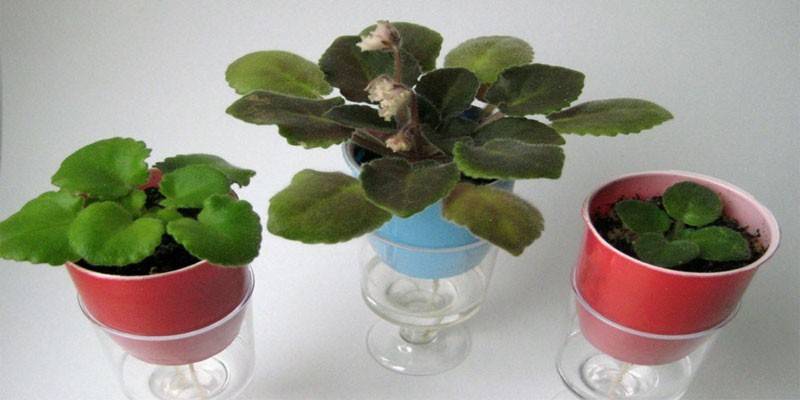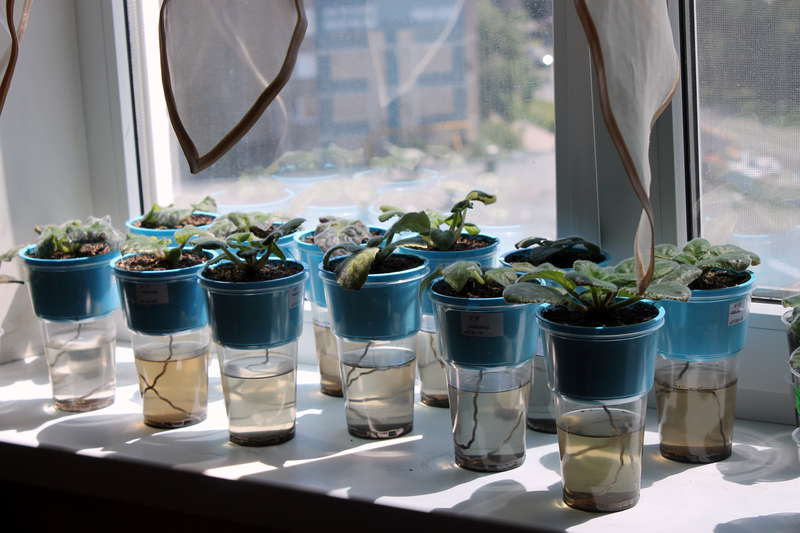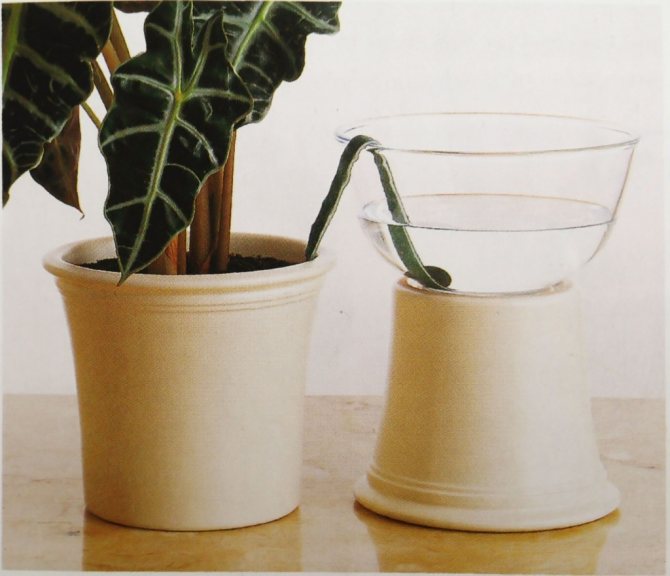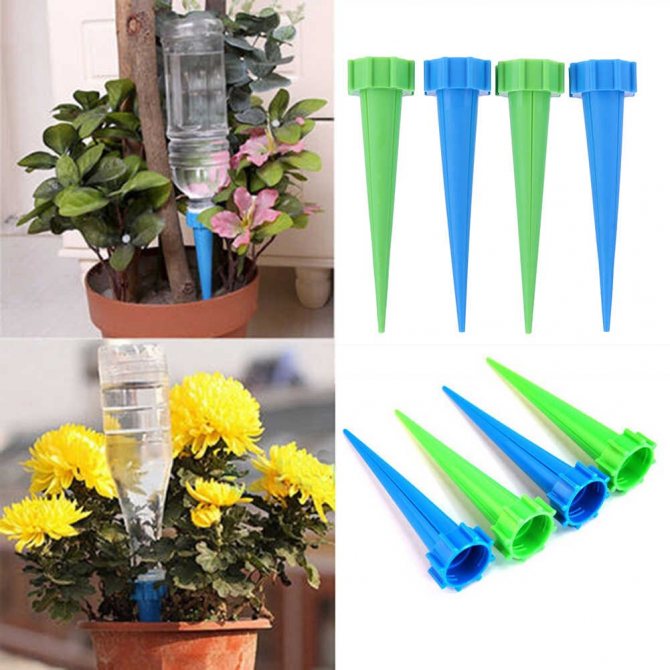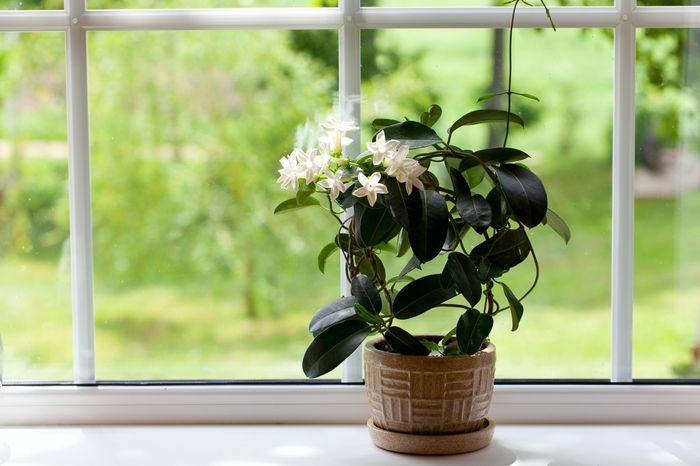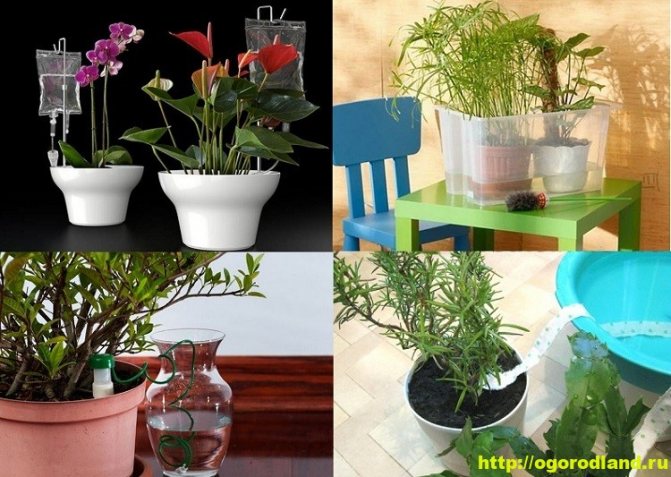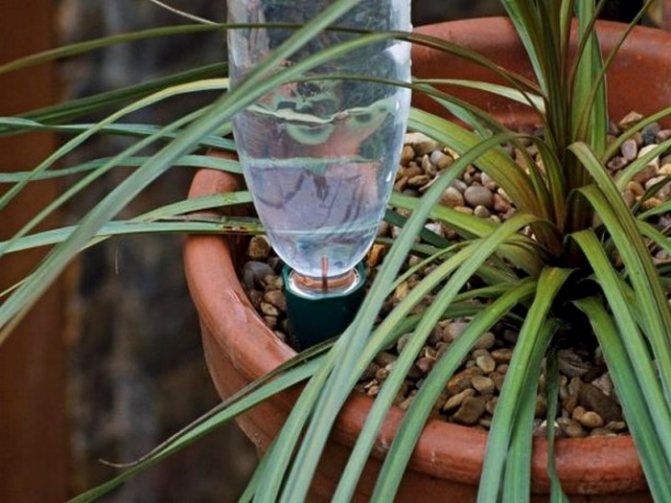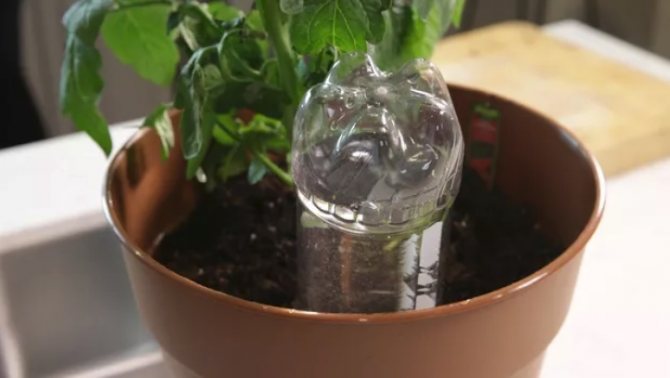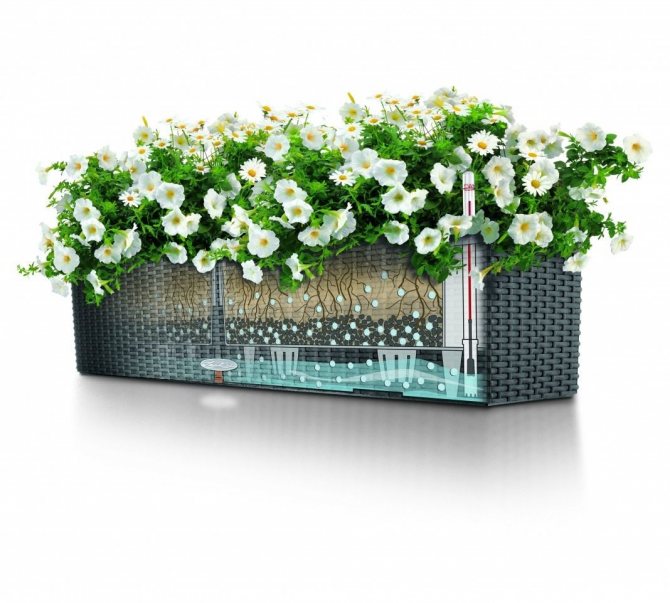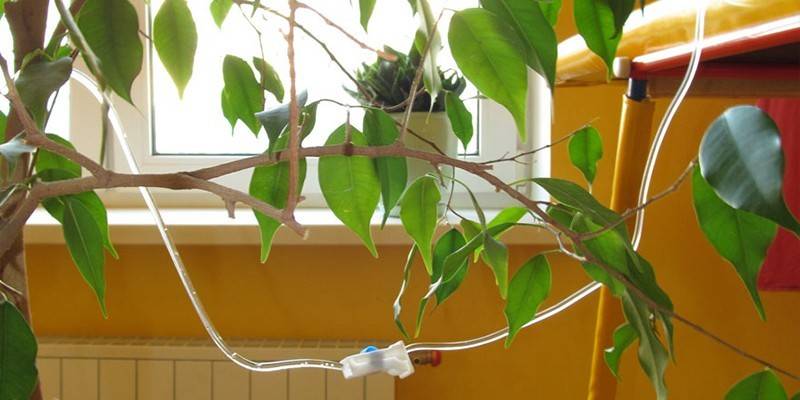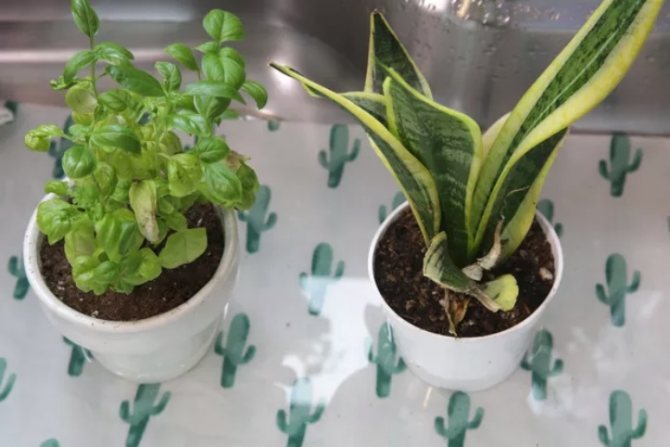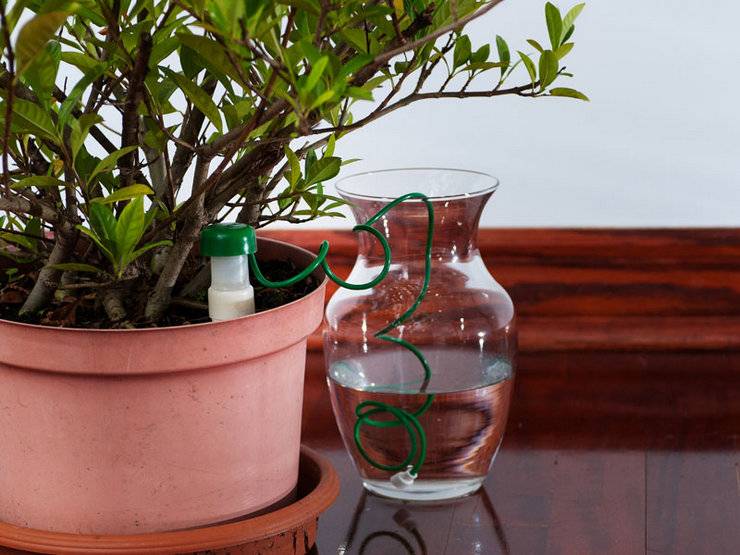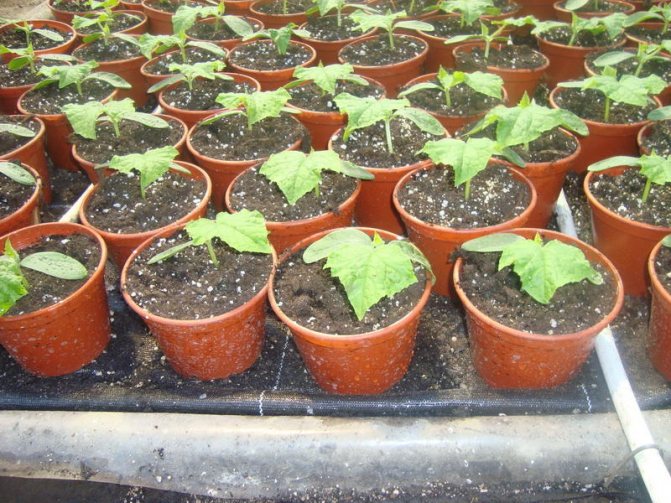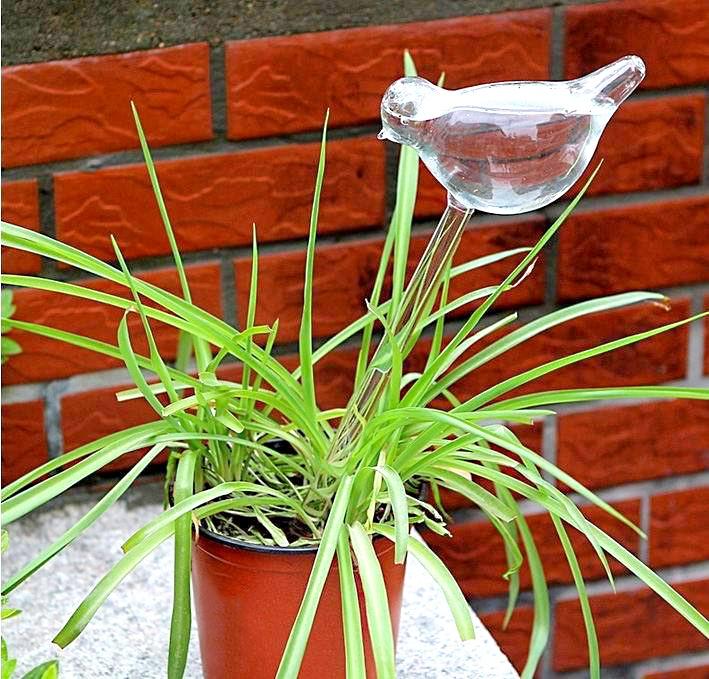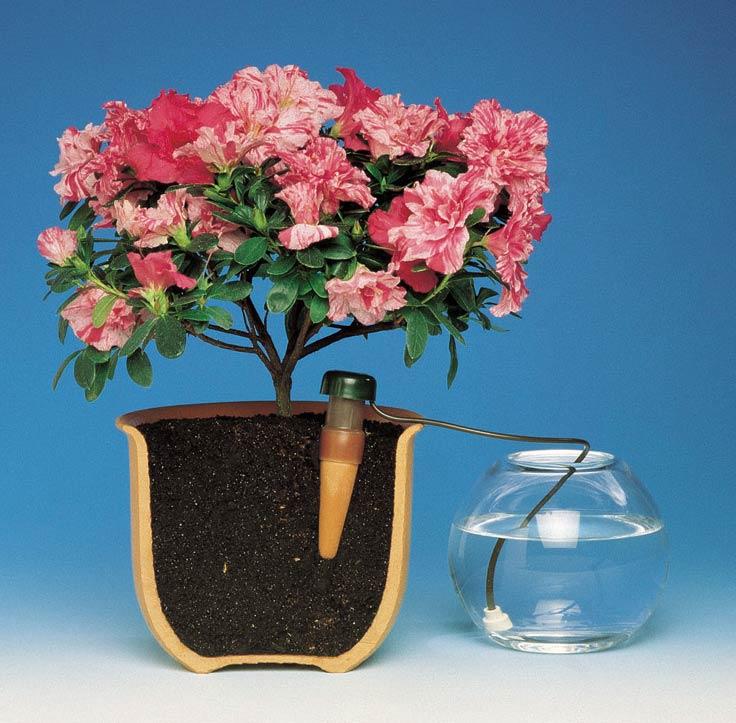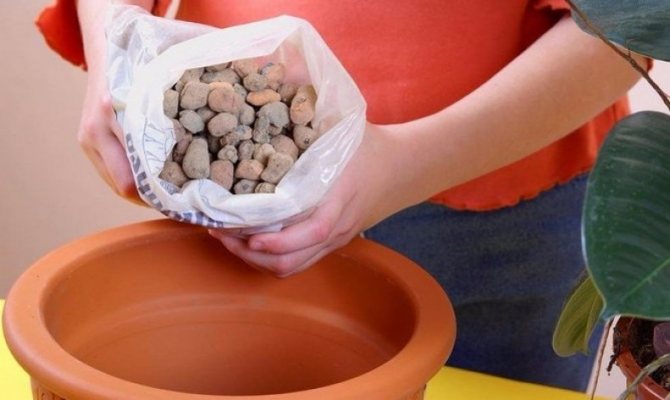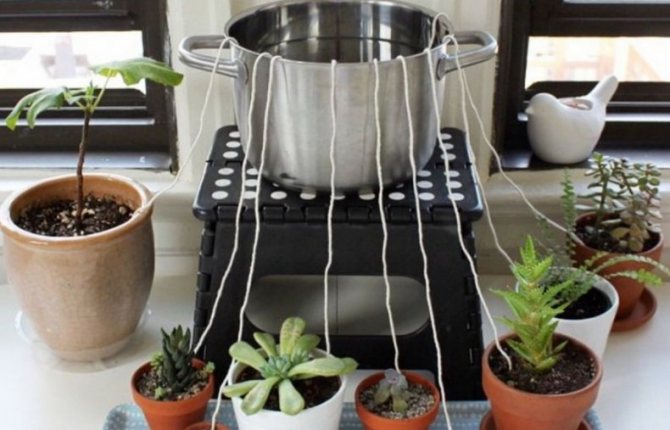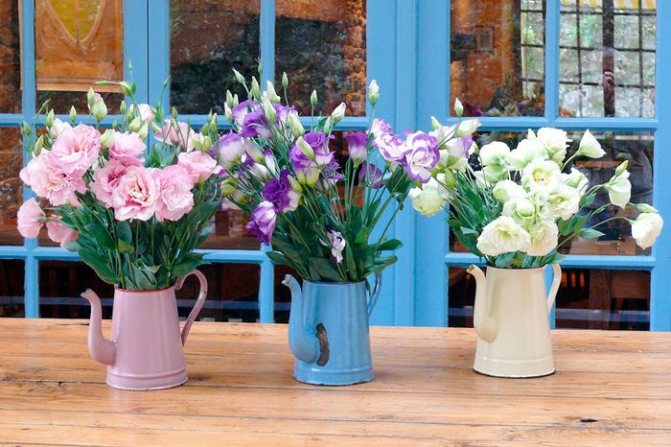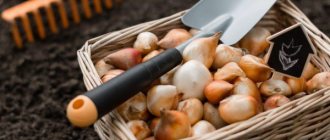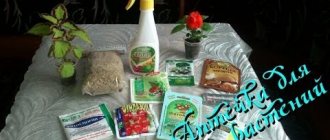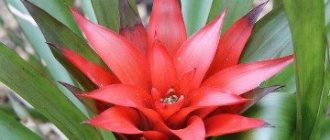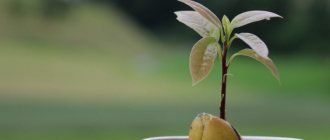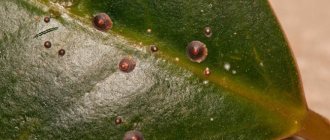Victoria

You can do drip irrigation yourself: you need to put a container of water higher, lower the edge of the twisted bandage (cord, rope) there, fix the other end in the ground with the plant
Indoor flowers require regular watering. But watering flowers while on vacation raises concerns or difficulties. I know ways to water flowers during extended absences — I'll tell you how you can do this.
How to leave flowers without watering for a month
Indoor plants can easily live without watering for two to four weeks if you take the following steps:
- water the flowers abundantly before leaving;
- remove the pots from the windowsill and close the curtains tightly;
- wrap the pots with damp newspaper, and wrap them with a plastic bag on top;
- cut off all buds and flowers, as well as thin out the leaf mass a little;
- small flowers can be covered with plastic caps, but so that air flows from below;
- place the pots more closely to keep the increased humidity around the flowers;
- place the pot with the plant in a larger container, and place expanded clay, which is moistened with water, in the gaps between the walls;
- you can put the pots in a basin, on the bottom of which put a material that absorbs water well, and on top of it lay a layer of newspapers, then open the tap so that water flows out of it drop by drop (water will moisten newspapers and material, creating the moisture necessary for plants).
Many of these methods are stressful for plants, but will allow them to survive your absence. Upon returning from vacation, you will have to try a little to return the flowers to their former splendor and beauty.
Where should you start?
Watering indoor plants in the absence of owners is not the end of the world. All difficulties can be easily dealt with if you go through the initial stages in advance:
| Picture | Plant preparation |
| Step 1. Remove exposed light sources . You can avoid losses in a slender row of pets if you remove them from open light sources (window sills, balconies, open air pots) in advance or close the curtains tightly. The main life processes in plants depend on lighting, and therefore less moisture will be consumed in the shade. | |
| Step 2.Eliminate drafts . Before leaving, it is imperative to check the premises with plants for drafts, it is better to close the doors in advance. | |
| Step 3.Remove damaged leaves . Remove any damaged or dried leaves, and cut off very large buds and shoots. Check regularly to see if the flowers are infested with pests or diseases. Treat diseased plants with special preparations, this will help keep flowers alive during your absence. |
How to keep flowers and keep them watered
If the vacation will be long, it is better to purchase a special drip irrigation system. But this option is not cheap, so you can get by with improvised means. The easiest way is to use a plastic bottle. It is necessary to pierce the cork of the bottle with an awl (so that the hole is small), fill the container with water, screw the cork and put the bottle in the ground with the neck down, deepening 2-3 cm.
The droplets flowing from the bottle will gradually moisten the soil.
Another well-known method is wick irrigation.For it, strips of fabric are taken that absorb water well. One end of the strip is placed in a pot and sprinkled with a little soil, and the other is placed in a vessel with water located above the surface of the earth in the pot.
Hooray! Finally, a long-awaited vacation. All thoughts are occupied with the upcoming trip. Just not to forget to take with you. And at some point it dawns on you "How to leave indoor flowers without watering for two weeks?"
Choosing the right method
Even the most experienced grower sometimes has unforeseen situations. For these purposes, you can choose the least costly method - both from a financial point of view and taking into account the amount of time. But how to keep flowers if you go on vacation, in perfect condition?
Among the various options are:
- requiring from us sleight of hand and some available materials;
- needing to use a special autowatering system.
3 options for automatic watering of flowers from scrap materials
What can be done in the shortest possible time to maintain the beauty and health of green pets? Instructions on how to make self-watering indoor plants with your own hands are presented in the table:
| Description | Illustrative example |
Option 1. Watering through the "wick":
| |
Option 2. Moisturizing through a cloth:
| |
Option 3. Plastic bottle:
|
Option 4 - professional tools
Today there are hundreds of ways to build auto-irrigation for indoor flowers. Automatic watering of indoor plants can be arranged using special devices. They can be found in almost any florist shop. The devices differ in cost and time during which self-watering is carried out.
Aquaglob
- the simplest design. This is a special vessel, usually made of glass (less often of plastic) with a thin tapered tube. The aquaglob is filled with water and lowered by the neck into the soil, the water gradually flows down and moistens the soil. When the soil dries up, the process of gas formation begins, air bubbles enter the vessel and part of the water again enters the soil.
What is the best watering system for indoor plants for you? To answer this question, first you need to determine what elements it should have:
- Containers for water and vessels
who will guide her; - Special tips
made of porous components so as not to clog up with soil; - Timer
to determine the time and frequency of watering; - Water flow regulator
in the tank; - Sensor
to find out the moisture content of the soil; - Pump
pumping up water.
The price of such devices can vary greatly. But in the future, you can safely leave flowers for the duration of your vacation.
How many indoor flowers can be without watering.
There are no options with relatives and friends who take the time to come and water the houseplants. It is not always possible to use the help of loved ones. Therefore, we are looking for other solutions on how to preserve indoor flowers when going on vacation.Some types of indoor plants need daily soil moisture, and some flowers can tolerate a two-week drought.
- a large amount of water is required by plants such as cyperus, calamus, azalea.
- the soil should be constantly moist (but without stagnation of water in the ground) in begonia, alocasia, calathea, lemon, oleander, ivy.
- decorative leafy indoor plants need to be watered when the top layer of soil in the pot dries a couple of centimeters. Dracaena, clivia, monstera, palms, syngonium, columne, aspidistra, aglaonema, it is important that the soil dries out between waterings.
- but before the next watering, the soil should dry completely near the hippeastrum, gloxinia, zygocactus, crinium, caladium, philodendron. Cacti, on the other hand, do not need moisture at all during the winter season.
Knowing how much moisture and how often your plants require, you will understand how long you can leave potted flowers without watering. And if the question is in your absence for up to five days, then, after watering the house plants, you can safely leave and not worry about how to leave the indoor flowers without watering.
Read Wikipedia about indoor flowers and their care.
Cooking flowers
To irrigate flowers autonomously during a long absence, they need to be prepared:
- Reduce watering... Water the plants less often before vacation than usual.
- Do not fertilize... When you feed a plant, it needs more water for all the minerals to be absorbed better. Do not fertilize the flowers at least two weeks before leaving on vacation.
- Trim buds and leaves... During flowering, the plant requires a lot of water, so 1 day before leaving, get rid of the blossoming buds and lower leaves. Cut off not all the leaves, but so that there is less greenery.
- Check if the flower is healthy... If the plant is sick, you need to fix the problem as soon as possible.
- Put away in a shaded place... Place the pot in the darkest part of the room: the water will evaporate more slowly and the flowers will last for a long time.
- Put all flowers together... By collecting all the plants nearby, you will increase the humidity in this area of the room.
- Water the flowers... Watering the flowers when you go on vacation should be abundant. Give the flowers a little more water on the day of departure than on other days.


On the day of departure, moisten the soil intensively to make up for water shortages
Before advising you how to save flowers if you are going on vacation, I read what they advise on the forums
I would divide the methods of automatic watering of plants into two categories - store systems and do-it-yourself ones.
How to keep indoor flowers without watering.
If you are leaving home for two weeks, then we do not recommend leaving indoor flowers without moisture. Otherwise, upon arrival, you will have to re-buy your favorite plants. There are two ways to protect indoor flowers while on vacation. One of them provides for the expenditure of the family budget, and the other - with minimal costs. You can risk leaving indoor flowers for a long time without watering, without any financial investment, you can do this:
- houseplants need to be prepared for your absence. For you, leaving home is a joy, but for flowers it is stress.
- we carry out pruning of buds and blossoming flowers. So we will help the plant not to waste its energy for flowering during the "separation" from you. Now they will direct all their forces to maintain their vital functions. Plus, you still won't see the bloom itself.
- we reduce the moisture consumption of the plant for this period by thinning the leaf mass. We'll have to make a sacrifice, since indoor plants will lose their decorative effect. Some of them will take a long time to recover, but it's worth it.
indoor flowers in ceramic pots need more water than plastic planters.
- we move the pots with house plants from the windowsills to the floor. Desirable in the far corner of the room.This is necessary in order for the plant to receive less light and heat. Reducing the amount of light and heat leads to a decrease in the amount of moisture evaporated by the flowers. And, as a result, the plant consumes it minimally. Upon your return, be mentally prepared for the fact that you will not recognize your home oasis. Without proper warmth and lighting, indoor flowers will slow down their growth.
- We put pots with indoor plants close to each other. Thus, a mini-greenhouse is created, which will keep the humidity around and in the middle slightly increased. The only thing I want to warn you about is that if you place indoor flowers in this way, you increase the risk of disease for all plants in the presence of an already sick one. After all, it is not always possible to immediately determine the presence of diseases or pests on any one flower. And then the affected flower will "reward" all other indoor plants with the disease.
You can ensure the actual watering of indoor flowers on vacation as follows:
- put all houseplants in a large bowl (basin, baby bath, tray). Cover the bottom of such an improvised pallet with a thick layer (at least five centimeters) of expanded clay. Fill the expanded clay up to half with water. And place flower pots on a wet layer. Also cover the spaces between the pots with expanded clay or cover with wet moss with sphagnum.
sphagnum moss is a good accumulator of moisture. The plant takes moisture from the moss as needed.
- to perfect the source of moisture for your indoor plants, we create a greenhouse. We cover all the flowers in the pallet with transparent plastic wrap. If there is no large piece of film, then you can create individual moisture keepers by putting plastic bags on each plant. Make an exception only for plants with fleshy or pubescent leaves. Such as Saintpaulia, Pelargonium, Kalanchoe. Otherwise, they will rot or become moldy without regular ventilation.
If you are worried about the effectiveness of any method of watering indoor flowers while on vacation, then prepare cuttings of your favorite plants. Until you return, they will sprout in a jar of water.
We immediately warn you that after you return from vacation, you will need to remove bags from flowers gradually. Houseplant accustoming to low air humidity and constant airing in the open should be done within a week, then removing, then putting back on the mini "cap".
if you can't find a pot for potted flowers, place the plant pots in the tub.
- you can ensure a constant supply of moisture using plastic bottles. To do this, make small holes in the caps. Then we pour water into the bottles and arrange them upside down either on the pallet between the pots of indoor plants, or directly into the pot itself. Dripping through, water will moisten expanded clay, moss, or soil.
moisture through the holes in the cap of a plastic bottle directly into the ground is good for large indoor flowers in tubs. For small plants, the bottle watering method will not work.
- many of you have heard about the following method. It consists in passive watering using improvised wicks. We twist bundles from ropes, laces, woolen threads, bandages or cotton fabric. We lower one end of such a wick into a container with water, and stick the other into the ground. At the same time, the container with water should be above the level of the flower pots. Due to the difference in capillary pressure, water will begin to flow to the plants.
for orchids during your vacation, a method of hydration is acceptable, in which the plant feeds moisture from the bottom. A pot with an orchid is placed in a container, at the bottom of which you pour a little water and pour drainage.
Irrigation systems for indoor flowers.
Watering indoor flowers during departure can be entrusted to industrial devices. Such systems will have to be spent. But the acquisition of such technologies will pay off at least by the fact that when you return from vacation, you will not have to buy new indoor plants again.
- autonomous watering systems for indoor flowers are called Aqua Globes. The simplest ones are a glass flask that is connected to a ceramic cone. The cone is immersed in the soil to provide uniform moisture to the earthy coma. The capillary-porous structure of the cone walls allows water to drip into the ground.
Before installing both homemade and industrial humidification systems for indoor flowers, test the rate and volume of water supply. And then adjust the required "head". This is necessary in order not to flood the plants and prevent the soil from drying out.
- The Austrian Blumat system is distinguished by the fact that the lower part of the conical cone is made of special clay, which is able to react to soil moisture and independently maintain the necessary moisture in the ground. Also, a thin hose is connected to the cone, with the other end dropping into a container with water. As soon as the soil in the pot with the indoor plant is dry, the system will begin to supply water drop by drop. The amount of water is regulated by the level at which the container with water is located.
- capillary mats are available for passive irrigation. These hygroscopic mats are sold in garden centers and large supermarkets in indoor plant care departments. The operation is very simple. After covering a pallet or even a kitchen table with plastic wrap, place a capillary mat on top and place pots of indoor flowers on it. Dip one of the edges of the absorbent mat into a container of water. Water will saturate the mat, and indoor plants can easily absorb moisture into the soil through the bottom of the pot.
by cutting the capillary mat into strips, you can use it as a bundle for passive irrigation.
By choosing any of these methods of watering indoor flowers during your vacation, you will not leave your home oasis without life-giving moisture. And upon your return, the flowers will thank you with wild growth and flowering. After all, they will miss you as much as you.
If vacation is a joy for you, then for indoor plants it is a serious test.
Before leaving, try to make sure that they painlessly survive the separation and greet you green and blooming.
The biggest problem flowers will experience during your vacation is the lack of water. You can solve it by purchasing special devices. The simplest one is powered by a Krona battery and has a reservoir for irrigation. This should be enough for 2-3 weeks. If you don't need additional expenses before the vacation, you can do without store equipment.
Eight tips to prepare plants for extended loneliness.
1
Remove the flowers from the windowsill or draw the curtains tighter. The less light, the slower the life processes in plants, which means they need less moisture.
2
Water the soil well so that it is saturated with water. The pot can be wrapped with damp newspaper and cellophane on top. This will reduce moisture loss.
3
Small plants should be covered with plastic or glass caps, bottles, but so that their edges do not go beyond the pot and let air through from below. The evaporated water will condense on the walls and drain back into the ground.
4
You can place a clay pot in a plastic pot of a larger size, and cover the space between the walls of the pots with expanded clay, abundantly moistened with water.
5
Take a plastic bottle, fill it with water for irrigation and pierce the cork with a heated awl or fine knitting needle. The same hole must be made at the bottom of the bottle.Then put it in a pot with the neck down, burying it 2-3 cm into the ground. Water flowing out drop by drop will moisten the soil for a long time. But such "bottle" watering requires a preliminary check. The holes can be too large, and then the soil will be waterlogged. Or, conversely, the water will flow out too slowly. Finding the optimal hole size can only be done by trial and error.
6
You can collect the pots in a basin and put them in the bathroom. Plants will stay fresh for a long time if the bottom of the basin is covered with a well-absorbent pad (felt, rug), and then several layers of newspaper are placed. Open the tap so that water flows out of it drop by drop. Just do not forget to leave the drain open, otherwise the neighbors will not be flooded for long. However, this method is not suitable for flowers that cannot do without sunlight for a long time.
7
Such a "plumbing system" also effectively moistens the soil: a woolen thread or bandage is dropped from one end into the ground in a pot, and the other end is dipped into a container with water, which should be located above the pot. You can also use wicks made from any fabric that conducts water well. It is only important to consider the size of the pot. For a small one, one connecting "pipe" is enough, and for plants located in containers of a larger diameter, several threads or wicks will be required. If the plant is not afraid of waterlogging, you can place the pot in a plastic bag when using this watering method and seal it on top with tape.
8
For plants that are grown in pots with good drainage holes on the bottoms, the following method can be used. Lay an oilcloth on the table (so as not to spoil the furniture), on it - a wide strip of any dense, well-moistened fabric (cloth, felt, gabardine rug, old baby blanket). Put pots with already watered plants on the fabric. The end of the fabric should hang off the table and sink into a large container of water placed just below the plants, such as on a high chair. In this case, the fabric lying on the table will not dry out for a long time, and the plants will receive water through the drainage holes of the pot.
Remember that all these methods are designed for a maximum of three to four weeks of your absence. If you have to leave for a longer period, then you cannot do without complex store-based automatic irrigation systems. However, they can be successfully replaced by neighbors or relatives.
5-7 days before departure, carefully check whether the plants are infested with pests and diseases. Remove all dried and diseased shoots and leaves, as well as large buds and flowers from the plant. Treat diseased plants with appropriate preparations.
It is better to cut off too large leaves.
Plants should be placed in a lighted place, but not in the sun.
Close both doors and windows so that there are no drafts in the room where the plants will remain.
Stop all types of feeding 2-3 weeks before departure.
If you are leaving your plants in a pan of water, place the flowerpots on a rock or wooden stand to keep the roots from freezing.
Flowers in ceramic pots tolerate separation better than those in plastic containers.
The most unpretentious
Tradescantia, begonia, dracaena easily tolerate a temporary lack of moisture. But in a week they will also want to "drink".
Aloe, agave, euphorbia tolerate temporary "droughts" and love sunlight, so it is better to leave them in the room on the windowsill, after watering well or providing drip irrigation.
Palm trees and ficuses that live on the balcony should be brought into the room during the holidays. And also provide drip (or other) irrigation. They, of course, are also unpretentious to moisture, but in three weeks of your absence they can get sick.
The benefits of indoor flowers have long been known.Enriching the air with oxygen and moisture, pleasing the eye with their beauty, they require constant care. When planning a vacation or a long trip, indoor plant lovers who have not had time to find those who look after the green guard, begins to overcome the alarming question - how will the flowers be watered during the absence of the owner? Fortunately, this problem has long been resolved. It is enough to properly prepare the flowers for your departure, install the automatic watering mechanism and you can set off with peace of mind.
How to water flowers while on vacation: do it yourself autowatering
To prevent the flowers from wilting during the holidays, it is necessary to somehow arrange for them automatic watering. Now there are special automatic irrigation systems on sale, but I wanted to do everything simply and with my own hands. I want to offer you several ways that I learned about. I must say right away that they all give a positive result, but you just need to approach each flower individually, because someone loves abundant watering, and someone, on the contrary, is categorically opposed to being poured.
Beforehand, our flowers must be prepared:
- Remove wilted buds so that they do not pick up excess moisture.
- Remove flowers from windows and, regardless of their preference for light, put in a shaded place.
- All methods must be tested in advance in order to correct and understand which is best for watering.
- On the day of departure, it is good to water the flowers.
Watering flowers by immersion in water
A very convenient way: we put flowers in pots in a large basin and pour water. In this case, it is advisable to put a spongy napkin made of porous fabric under the bottom of the pot, which will absorb and retain moisture. And fill the space around the pots with crumpled newspapers, which will not only hold moisture, but also prevent the rapid evaporation of water.
With this method of watering, the plant will take moisture little by little and without the danger of root rot.
This method is suitable for those plants that like moderate watering, for example, violets.
To be honest, I found out about him long before the trip, and when it came down to it, I forgot about the sponge and newspapers. But I know that in general, flowers from time to time should be placed in a bowl of water for at least a day, so that both the walls of the pot and the roots of the plants are well wet.
I hadn’t performed this procedure for a long time, so before leaving I immersed spathiphyllum, euphorbia and zephyranthes in water. I poured a lot of water and did not dare to put the violets.
All the days of my absence, the flowers, apparently, felt great, the ground remained moderately moist. Spathiphyllum even bloomed while I was away.
So leaving flowers for 10 days is quite possible, I really liked it.
Wick irrigation
I put a bucket of water in the center of the table, and around I placed violets, gloxinia and hippeastrum to accompany them.
She twisted the flagella from the bandage, dipped one edge of them into the water, and the other into the pot with the plant.
Thus, water gradually through this wick from the bandage enters the ground and watering is carried out. To ensure this, the water level in the container must be above the ground level in the pots.
I covered the bucket with a lid so that the water would not evaporate in vain.
And be sure to check the work of the method in advance, determine the acceptable width of the bundle. At first I tried to twist a bandage 14 cm wide. But after a day, the ground in one experimental pot with gloxinia was too wet, and even the tray was filled with water.
Therefore, at the time of departure, I cut the bandage in half lengthwise, i.e. it was 7 cm wide and my flowers did not wilted during my holidays.
An excellent method, I liked the fact that the width of the bundle can be adjusted to the speed of watering and you can leave the flowers like that for 10-15 days. If the flower is large, then several flagella can be laid to it.
But only with hippeastrum I had a misunderstanding: the wick fell out of the pot and all the water poured onto the table. The plant was not upset because of this, it does not really like water, it seemed to me that it even got prettier and stronger.
But you need to take this point into account and dig the wicks a little into the ground for reliability, and the length of the bundle should be such that its other edge is well immersed in water.
Drip irrigation
Here you need a five-liter bottle of water and a dropper - the same one that is sold at the pharmacy for medical procedures.
All needles are removed from it and a tube is left, which is placed in a bottle, the tip is suspended over the plant.
A clip in the dropper allows you to control the amount of water.
Watering flowers with a dropper is suitable for plants that especially love moisture, such as cyperus, lemon, azalea, begonia.
In this way, you can water the flowers when you leave for a long time, for 2 - 2.5 weeks.
Watering flowers while on vacation: a video, the tips from which I took note of and in which the above methods can be seen visually:
Watering from a bottle
For large plants growing in large pots, you can arrange drip irrigation from a bottle, it is not at all necessary to buy a special dropper.
To do this, water is poured into a plastic bottle, screwed with a lid in which you need to make a small hole, and this structure is installed in a pot.
I was going to water the palm and cyperus, which are sitting in my buckets. But my mistake was that I made the holes with a hot nail, they turned out to be too large, and the liquid dripped at too high a speed.
When using this method of watering, you need to make tiny holes with a needle and check the work a few days before leaving.
I didn’t experiment any more, but simply poured water over the plants well: poured it on as usual and poured one and a half liters more. Such watering was enough for them.
Hydrogel
The fact that you can use the hydrogel on vacation, I learned only now, when I began to write this post.
Hydrogels are small balls that swell in water and release moisture as needed. You can buy the hydrogel at flower shops.
Before leaving, the plant is watered and covered with hydrogel balls on top. And you can safely rest for 10 days, during which time the plants will feel comfortable.
There are probably other ways to water flowers on vacation. Share who knows what, write in the comments. And I was completely tripled by those that I told you about.
Interesting information for you:
If you are going on vacation for a couple of weeks, it is important to provide the necessary conditions for the indoor plants. Then the flowers will greet you green and viable on your return. Watering flowers can be entrusted to relatives or neighbors, but this does not always work. How do you leave the plants in this case? In this article, we'll show you how to leave flowers while on vacation.
There are many ways to leave flowers on vacation without watering.
Preparing indoor plants for vacation
Indoor flowers left unattended for a long time, experts advise to prepare. This can be done as follows:
- A couple of weeks before departure, stop feeding the plants with various additives. This is necessary in order to slow down their active growth and somewhat reduce appetites.
- When there is 8-10 days before the longed-for vacation, you need to carefully remove all sick and affected leaves.
- It is recommended to remove flower pots from window sills immediately before departure;
- The buds need to be cut off. This minimizes fluid consumption. This should be done carefully, taking into account the plant's ability to recover later.
- Thoroughly spill the soil in the flowerpot with water, while it is important not to overdo it. The earth should be saturated with liquid, but not wet. It will be possible to reduce moisture evaporation if you wrap the pot with a dampened newspaper and cellophane on top.
- It is desirable to place all pots in a large container with liquid poured at the bottom. However, they should not touch the water. Thus, it will be possible to achieve the desired level of humidity near green spaces.
- Around the leaves, it makes sense to make a dome of transparent film. This procedure allows you to create something like a greenhouse.
- Earthen pots would be nice to fit into larger plastic containers. Fill the resulting void between the walls with expanded clay soaked in water.
Which flowers tolerate drought more easily?
Various factors affect the survival of indoor pets without moisture.
- Plant type.
Flowers in a home collection can vary greatly in origin, appearance and developmental characteristics. Most houseplants can be safely left for a week without watering, after moistening well beforehand. Prolonged lack of irrigation can negatively affect the health of indoor pets.
Herbaceous plants in winter are watered on average once a week, and during the period of active growth or flowering - once every 3-4 days. Orchids have about the same irrigation regime. Agave, hoya, yucca and aspidistra are not so demanding for watering - they are content with moisturizing once every two weeks. Popular asparagus and chlorophytum tolerate drought well at low temperatures due to the presence of water in the bulbs. Cacti and succulents are left without watering for a month if they are in a dormant period, and the ambient temperature is from 5 to 10 degrees Celsius. For many representatives of this species, such content is the norm.
"Plants-water-lovers" hardly tolerate long-term lack of watering. These include, for example, azalea, streptocarpus, cyclamen, etc. It is better to hand them over to someone for care during a long absence. If trips from home are often and for a long time, it is worth choosing less moisture-loving plants for growing. Flowers with tough leaves and a thick trunk will easily tolerate an anhydrous period of up to 2 weeks.
- Air temperature and humidity.
In a warmer room with low humidity, pets will begin to suffer from a lack of moisture much earlier. If a long trip takes place in winter, it is appropriate to reduce the temperature of the central heating radiators. Additional containers of water in the room will help increase the humidity.
Homemade autowatering systems
Everyone can prepare simple mechanisms for autowatering on their own at home.
Wicks
You will need a fabric that is excellent at absorbing moisture. It is cut into strips from which wicks are twisted. One end of the device is buried in the soil of a flowerpot, the other is placed in a container with water. As the soil dries, the wick will moisten it. Moreover, it should not just be wetted with water, but absorb it well. This must be followed. Important! This wick method can be used for up to 10 days.
The disadvantage of this method is that in the heat, the tissue flagellum will dry out quickly, and the liquid will enter the ground in small volumes. To improve the situation, it is recommended to purchase special wicks and rods made of porous ceramics. With such devices, drying out can be avoided.
Medical droppers
An excellent autowatering system will come from droppers used in medicine. One end is placed in a container with liquid, the other in the ground, preferably closer to the edge of the pot. When leaving for a short time, it is better to use the clip provided with the dropper.
When planning a long trip, it is recommended to close the tube by puncturing a small hole in it. Or make the gap in the needle narrower.
Alternatively, you can place a porous atomizer at the end of the tube (these are usually used to supply air to the aquarium).
Plastic bottles
A fairly simple, but quite effective method using plastic bottles.Such a container is filled with liquid to the very neck. A small hole is made in the lid that closes the bottle. The resulting device is turned upside down and screwed into the soil of the pot. Water, gradually flowing through the hole in the lid, will moisten the soil. To speed up watering, the bottom of the bottle should be punctured. It is important to make sure that the hole is very small. In this case, the water will not flow out more than it should be and rotting will be avoided.
Remote humidification methods
- Moisturize with a wet cloth.
On a table located far from the window, put a thick oilcloth to protect the surface from moisture. Place a piece of wet, thick cloth on top, such as an old baby blanket or a flannel diaper. Place a container with water nearby. Lower the ends of the matter into a vessel with liquid. Place pots with well-watered flowers on a wet cloth (use pots without supports and with drainage holes). Water from the container will gradually fall to the roots through the bottom of the flowerpots and water your green favorites. You can put plants in the bathroom if there is enough light - then the film is not used. With this method, you can leave the flowers without irrigation for 2-3 weeks. Watering flowers while on holiday using a wet cloth is good for medium-sized, moisture-loving plants.
Make a thin hole in the cork with an awl, fill the container with water. Twist the bottle and insert it upside down into a flower pot, pressing it into the ground by 2-3 cm. Water from a small hole will drop by drops into the flowerpot and water the plant. On the other hand (in the bottom), you also need to make a hole so that air can enter the container instead of the leaked liquid. In advance, it is advisable to prepare several bottles with holes of different diameters and experimentally establish what size of the hole will be optimal. This is a great opportunity to water flowers when you go on vacation, you just need to correctly calculate the water rate so as not to overmoisten the plant. The disadvantage is that each flower will need its own "watering can" - you need to stock up on bottles. This method works well for large specimens.
- Wick irrigation.
Flower pots are placed on the floor. Pour water into a large plastic container and place it next to the plants. Dishes with liquid should be higher than flowers - for example, on a table or high chair. Cuts are made from fabric or bandage, you can use special synthetic wicks that are sold in flower shops. One end of the fabric is placed in a container with water, and the other is fixed on the surface of the soil in a flower pot. The wicks are gradually fed with water from the dishes and supply the plant with moisture. For large and moisture-loving flowers, more cuts are used. On average, one wick is used for one flowerpot with a diameter of about 10 cm; with a pot diameter of 30 cm, 4 such pieces of fabric may be needed. This method of watering will keep the flowers up to two weeks.
This system will automatically water the flowers at regular intervals. It is better to buy it in advance to check the efficiency of the installation. First, there is still a risk of getting a low-quality product. Secondly, it is necessary to adjust watering taking into account the requirements of pets.
Also available for sale. They are not cheap and are not suitable for all flowers, but they can be an alternative for those who are willing to spend extra money for the comfort of their plant. So, during a long absence of the owners, indoor flowers can quite comfortably live without watering. Preparing your plants for the dry season and following a few simple tips will help you avoid stress.
Man cannot live without rest, and plants cannot live without water. Sometimes these needs come into confrontation, because few people would think to take indoor flowers with them on vacation or refuse a long-awaited trip in order to provide care for houseplants.As a rule, we trust close relatives and friends to water flowers while on vacation. However, this solution is not always feasible. Firstly, once again you do not want to burden others with your worries. And, secondly, relatives and friends may simply not know how often and with what intensity to water your violet, geranium, crocus, etc. To save yourself from unnecessary worries, we suggest that you familiarize yourself in advance with the most reliable and effective ways to organize automatic watering of indoor flowers during your absence.
Devices for automatic irrigation of indoor flowers
Specialty flower shops can find several useful devices that can automatically water flowers while on vacation. Let's take a closer look at their features and effectiveness:
Aquaglob.
This device is made in the form of a round flask with a very narrow spout. The essence of the device is quite simple: the aquaglob is filled with water, turns over and plunges into the soil with a narrow part. Since the opening of the flask is extremely thin, water does not pour out of it immediately, but seeps out gradually.
Depending on the size, the aquaglob can provide automatic watering of flowers for a period of one to two weeks.
Blumat,
which in translation means "carrot" refers to an automatic drip irrigation system. The design of this device includes a tapered base and a plastic tube. The base is immersed in the soil, and the tube is immersed in a reservoir of water. Since the system is equipped with special sensors, water is dosed into the soil. When the earth dries up, the device fills it with water, but if there is enough moisture, the valve on the sensor closes, and moisture is not transferred. Thus, the device "waters" the flowers as long as there is water in the tank.
Pots with automatic watering.
The pots and pots with automatic watering are equipped with a special system for storing and transferring water, which is located at the bottom of the products. When you water the flowers, the remainder of the moisture remains in the device and then spreads evenly over the soil as it dries.
Some of these pots and pots, in addition, are equipped with an indicator that allows you to set the mode and intensity of watering for several weeks in advance.
Automatic irrigation mechanisms
If you do not have time or desire to arrange the autowatering system yourself, you can buy ready-made and convenient mechanisms in any flower shop. Their high cost is justified by their reliability and efficiency in use.
- Gardena
- a device that allows you to provide metered watering for indoor flowers that need different amounts of moisture. The mains-powered system provides plants with water once every 24 hours. One device is capable of watering several pots at the same time. - Blumat
- a mechanism consisting of a narrow ceramic cone and a silicone tube. The cone should be thrust into the ground, filled with water and closed. Dip the end of the tube into a container with liquid. Moisture will gradually be absorbed into the ground, seeping through the porous walls of the fixture. As the water leaves the cone, a new portion will flow from the vessel through a straw. - Oasis
- a convenient, completely autonomous system that holds 25 liters of liquid. The unit is powered by a battery. It is capable of watering up to 20 pots over a period of 2-5 weeks. - RAIN SMART
- domestic dosed irrigation system powered by electricity. Able to dispense from 50 ml at a time. up to 3.5 liters of moisture. The watering frequency can be adjusted.
Using a hydrogel
In order for indoor flowers to remain without watering for a long time while the owners are on vacation, they use a hydrogel - polymer granules. 1 g of this substance is able to absorb 200 g of liquid and gradually give it to the substrate with the plant.Using a hydrogel as an additional source of moisture is only suitable for indoor flowers that require frequent watering.
If, before the vacation, make 3-6 holes in the substrate of the flower pot with a pencil (depending on its volume) to the very bottom and add 1 g of hydrogel there, after abundant watering, you can leave the plant for several weeks. There is enough moisture for the normal existence of the flower until the owner arrives. With the help of a hydrogel, you can significantly reduce the frequency of watering indoor flowers. To do this, when transplanting a plant, you need to mix the soil with polymer granules (3: 1).
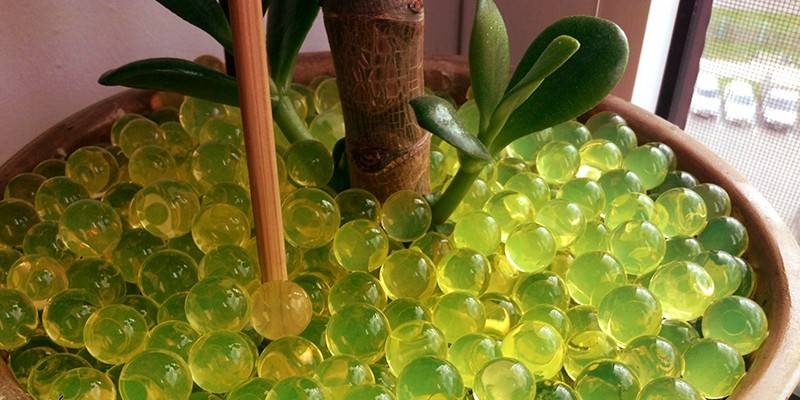

"Smart pots" for automatic irrigation
If it became known about the upcoming long absence in advance, you can purchase special pots. A few months before the trip, indoor plants are transplanted into such containers, consisting of three parts:
- top (for soil);
- middle (intermediate layer consisting of a mesh material);
- bottom (for water).
You need to plant flowers in such a pot in the most usual way, and also take care of it. But when a few months have passed, the roots of the plant will sprout through the middle reticular layer and the flower will receive the necessary moisture from the lower reservoir.
Watering methods for plants
Having completed the preparation of indoor plants, you can start organizing automatic watering. The simplest and most effective ways:
| Name | How long is enough | Benefits | disadvantages |
| Pallet in the form of a wide basin or a spread with high sides | Drip irrigation (wick, dropper, plastic bottle) |
|
|
| Hydrogel |
|
|
How to care for your plants after you return
Those who have used the autowatering methods described above are not threatened with unexpected surprises in the form of dried, wilted or ruined indoor flowers. Upon returning, you must carefully examine each plant, remove rotten or dried parts. Soak the soil in pots with water by means of bottom irrigation. It is not recommended to expose plants to light immediately. Better to teach them bright light gradually.
Caring for indoor plants during a long absence of a person is necessary. Automatic or self-made irrigation systems are a great option for those who could not find a "nanny" for their green garrison.
Types, material and shape of the pot
Caring for flowers is greatly simplified if it is carried out systematically and taking into account the characteristics of each plant. But not only the variety of this or that type of flower plays a key role, it is also important that the material from which the pot is made is of high quality.
And in order for the plants to feel good enough during your absence, you need to pay attention to the size and material of the container. The types and shapes of pots that would become cozy houses for indoor flowers are varied. The main options are:
- clay;
- plastic;
- ceramic.
Each of them can be either with the presence of holes on the side or bottom, or without them (pots). Separately, you can highlight pots with automatic watering systems.
Do not forget that for some plants, for example, you need to be especially careful when choosing a container. So, in clay pots, flowers that require very frequent watering may not take root. Therefore, they should be used only after a thorough study of the features of a particular flower.
It is convenient to plant young plants in plastic pots, this greatly simplifies the process of their reproduction. It is advisable to use clay and ceramic pots for adults with sufficiently overgrown flowers.
So, if most of your indoor plants live in clay pots, then one of the surest ways to water flowers in a long absence is to move this container to a larger plastic container.
The space between the walls must be filled with damp expanded clay or a well-damp cloth. With plastic pots, things are a little easier; it will be enough to place the plants in small containers filled with water so that the bottom of the pot is in the water.
Method one. Almost automatic watering
This method is as ancient, old and indestructible as the practice of floriculture in Russia. It consists in the fact that among your closest circle, you first need to choose a victim, and then appoint it - responsible for the life, health and flowering of your pets. A neighbor, girlfriend, mother, mother-in-law, own husband is perfect for the role of a victim ... Add the list yourself.
So, the autowatering system of the “neighbor” type has been established, all you have to do is to bring the wonderful gardener up to date - who and how often to water, where and when to turn on the lights, what and in what quantities to feed, how to bathe, etc. etc. You can play it safe and stick a note with a short guide to action on each pot.
This method guarantees you an excellent tan and a good mood for 2-3 weeks and even more.
Drip irrigation from a plastic bottle
A self-watering system from plastic bottles will provide plants with moisture for 15-20 days. To do this, you need to prepare containers with a volume of 1.5 and 2 liters and test the device before leaving on vacation to determine how much water each flower will need. To make a sprinkler, you need to make holes in the lid and bottom of the plastic bottle with a hot nail, thick needle or awl. Then pour in the liquid, screw on the cap and immerse the bottle with the neck down into the pot. This system is suitable for the constant supply of moisture to large plants.
Automatic watering of flowers in pots using a dropper tube is very effective. You need to remove the tip from it, place one end on the surface of the ground, and attach a weight to the second and lower it into a container of water placed on a dais. With a large number of plants, several such tubes will be needed, which must be tied together at the point of attachment of the sinker. If you adjust the flow rate correctly, indoor flowers will be provided with moisture for a long period. This sprinkler is suitable for any plant.
Method two. Water - water is everywhere
This old way says: collect all the flowers in the house, take them to the bathroom, arrange freely. Fields from the heart. And leave it there, if there is a window in the bathroom. Just do not forget to plug the hole in the bathtub, and pour a little water. Quite a bit, about 1/3 of the height of the pots. Remember that clay pots evaporate moisture faster than plastic ones, so it is advisable to wrap them with wet moss. Or you can place a clay pot in a plastic one, and fill the space between the walls with wet moss or wet expanded clay.
If you have plants that do not tolerate the "feet in the water" position, limit them to only abundant watering.


This method promises a calm rest of the grower for 7-10 days.
And he guarantees that upon arrival you will find your flowers in full health and in the same composition.
Method three. Physics must be taught!
The technology of such watering of plants during our absence came to us again through the centuries. And although it is based on the laws of physics, its external content is more reminiscent of subtle choreography, or rather, dances with tambourines.
You will need a large water container, the largest you have in your home. A certain amount of woolen thread, bandage, or any other absorbent material.From a bandage or thread, you need to twist the wicks, one end of which will be immersed in a vessel with water, and the other will go straight to the pot with the plant, where you will need to dig it a little.
Remembering that physics is to blame for everything, you will have to debug this hellish unit so that the water through the wicks neatly flows into the pot, and does not pour Niagara into it. You may need to experiment with the height of the water container relative to the pots. In any case - do not tackle this method at the last moment as a lifesaver. Test it first in practice. Still, physics ...
If the practical part of the task is completed "perfectly", you can safely lie on the beach, climb the mountains and weed carrots in the country during the same 7-10 days.
Method four. Bottle game
The hundredth rule of the florist says: never throw away plastic bottles from under the hated cola, healthy mineral water and other various and ugly drinks. Perhaps it will come in handy!
So, if it came in handy ... We take a bottle, pour water into it, close it with a cork. Armed with a knitting needle or a thick needle, we make several holes in the bottle cap, heating the production tool. Do not try to immediately make huge holes in the lid, turning it into a sieve. First check how it works.
With the lid upside down, insert the bottle of water into the pot with the plant to the depth of the lid - about 2-3 cm. Watch! How soon the earth is saturated with water, how quickly the bottle empties, how the plant will feel at the same time.
You understood everything correctly - this is again a method that requires verification before flying to the south.
If these experiments in field-field conditions ended in victory over drought, think for yourself how long you can go away from home without losses among your plants. Usually - week, another guaranteed to you
.
What water is suitable for watering indoor flowers and potted plants
Water for watering plants can be taken directly from the tap. Tap water is hard, so stand at room temperature for several hours before watering. Heavy metals in tap water, which are indistinguishable to human vision, collect at the bottom, so after the water has stood, never empty the container completely - always leave a few centimeters of water with sediments at the bottom.
Dip one end into a container of water (to the bottom), and fix the other inside the soil in each pot. As long as there is water in the container, the cotton strips, using the laws of physics (using surface tension force), will help keep the soil in the pot moist.
The disadvantage of this method is the need to select several containers (for three flowers, 1 liter of water per week will be enough), as well as the danger of drying out the soil in the event of a long absence (after the water runs out).
3) 3. Flower flasks are very popular and can be purchased or made by hand from a suitable bottle, jar, or medical dropper.
3.1. Pour water into the bottle, put a rubber cap on the neck from a regular pipette. Pre-make a small hole in the cap for water.
Place the water bottle upside down in the ground - the bottle will be upside down with the neck in the ground, the soil resistance will not allow the water to drain out completely, and your houseplants and potted flowers will be supplied with the required amount of water upon departure. If it is difficult to find a rubber pipette tip, then you can make small holes right in the bottle cap so that water can gradually flow through them.
You can also attach the tubes to a large, for example, a five-liter bottle, which must be placed above the plants. The tubes in the bottle can be secured with ordinary electrical tape, if necessary.
3.2 Take a medical dropper and hang it over each flower pot separately.You will need as many drippers as there are flower pots in your home, and also consider additionally the system for attaching the drippers over each of the flower pots separately.
3.3. Get a 3 liter jar, a cotton towel, and a plastic tray. Place a towel on a tray, pour water into the jar and close the neck of the jar with the tray with the towel in such a way that the side with the towel touches the neck of the jar (see example 3 in the picture).
Press the tray firmly against the neck of the can and turn the can structure upside down. Gradually, the cotton towel will soak in the water from the jar. Place flower pots on a towel without the bottom saucers so that the hole at the bottom of the pot is on the towel. The edges of the tray will prevent water from the towel from draining to the floor, and the roots of plants through the hole will be able to receive moisture in the required amount. This method is not suitable for plants growing in pots (for example, watering orchids).
The simple and inexpensive method is complicated by the process of fixing the bottle and can of water in an inverted position, the need for a large number of droppers, as well as the limited amount of water in the bottle, can, flask or dropper, which may not be enough for the entire time of departure.
4) 4. The effect of a closed system of water circulation can be created using a transparent plastic bag: cover the open ground in a pot with a bag (you can put a few pebbles on top to fix the bag more tightly), and put a larger bag on top.
Polyethylene will slow down the evaporation of water, and the evaporated moisture in the form of droplets will settle on the walls of the bag and again serve as a source of moisture for plants. The package must be transparent so that sunlight can penetrate to the plants and maintain its strength. This method is suitable for trips for several days (no more than a week), and only for small plants (because you rarely find large plastic bags).
5) 5. Aqua primer is a transparent or colored hydrogel soft balls that are composed of collagen. Collagen, upon contact with water, absorbs it and holds it inside.
Aqua primer hydrogel is used for bouquets of cut flowers: multi-colored balls look very beautiful in a transparent vase, turning an ordinary bouquet of flowers into the main decoration of the interior. Aqua soil can be scattered over the surface of the earth in a pot, moisture will be enough for a week of absence. Once dry, the hydrogel beads can be reused by placing them in water.
Her Majesty's gardeners hope their advice will help you maintain the beauty and health of your potted plants and flowers!
During a long absence of the owners due to a business trip or vacation, the plants suffer from a lack of water. However, it is possible to save flowers without watering if you take care of them before you travel.
The fifth method. Medical
It is suitable exclusively for doctors, paramedics, obstetricians-gynecologists, operating nurses and other medical workers. Because only they with knowledge of the matter will be able to supply the "patient" with a dropper. Drip irrigation is not a new invention, but sometimes you can look at it from a different angle.
The principle is simple. You need to attach a medical dropper to the water tank in any way and adjust the water supply to the plant pot using the coveted wheel.
This method gives you freedom for 1-2 weeks.
so that you can heal your nervous system, which is loose on the flower fronts.
We transport plants to the country
During the summer vacation, some of the flowers can be taken away with you. But it is undesirable to immediately transfer them to the garden: you can burn the leaves in this way, for several days they need to stand under the roof so that they get used to the air.
Individual plants can be safely planted directly into the soil, while taking into account how much they need the sun.Coleus, croton, cacti and geraniums are bright and open places, while ferns, begonia and fuchsia love a little shade. Plants such as abutilone, hibiscus, hydrangeas, roses and oleander are best "walked" in their pots, which are slightly dripped into the soil.
Sixth method. Let's go to checkmate
On capillary mat. What did you think about?
You will need a piece of absorbent material (an old blanket, for example), a free table near the sink, and a drain plug.
Water the flowers generously before parting. After closing the drain in the sink, pour water into it. Get the blanket wet. On the table next to the sink, first spread any material impermeable to water (oilcloth, polyethylene, etc.), then an old blanket so that one edge of it lies on the bottom of the sink, absorbing water. Place the plants on the other end of the blanket, on the table next to the sink. You can and should put quite tightly. The water will rise up through the capillaries of the tissue, and the plants in the pots (we remember that each of them has a drainage hole) will absorb water on their own.
Wick method
To organize watering of indoor flowers with the wick method, before leaving on vacation, you need to make a wick from fabric, bandage, gauze or woolen thread. One end must be placed at the bottom of the pot, removed through the drainage hole in the container, and then transplanted the plant. Place a container of water under the pot and lower the second end of the wick there.
If the transplant was not planned, you can organize wick watering of indoor plants in the absence of the owners in a different way. One end of the cloth (rope) must be placed on the surface of the pot, pour the substrate on top, and lower the other into a vessel with liquid located on a hill. The wick method is suitable for small flowers (violets, saintpaulias) and can always be used.
Watering through the drainage holes in the pot
Automatic watering of plants during a 20-day vacation can be organized using a long piece of fabric (towels, thick batting, unnecessary blanket). A stand for flowerpots is covered with foil, and a damp cloth is placed on top, one edge of which is dipped into a basin of water. Pots with well-watered plants are placed on a stand on top of the fabric. It is important that there are drainage holes at the bottom through which the flowers will absorb moisture.
- How to feed cucumbers after planting in the ground
- Top dressing of tomato and pepper seedlings with folk remedies: fertilizers for a good harvest
- Sprinkler for lawn and vegetable garden irrigation. Overview of models, types of sprinklers and tips for choosing
What not to do
The only and main mistake of a florist when going on vacation is to fill the plants up to capacity, hoping that this volume of water will be enough for them all the time. As a result, root rot often develops. Or the soil simply dries out to a stone state. Reanimating such plants is very difficult, sometimes impossible.
If you ask relatives and friends for a service, be sure to leave them detailed instructions - what, when and how much to water. For those with no experience in floriculture, with the best of intentions, the more water, the better for the plants.
Drip irrigation systems at home
One of the options for long-term preservation of the life of the flower during the departure of the owners is the drip irrigation system. Its work is based on the fact that the liquid falls on the ground from above, flowing out of the reservoir in a metered manner. Designs for drip systems are different. So, for example, if the neck of a plastic bottle is not immersed in the ground, but a vessel is fixed over a pot with a plant, then one of the options for a drip irrigation system will turn out.
The second version of the drip irrigation installation is made using medical drip systems, which are sold in any pharmacy. The same bottle of the required volume is used as a reservoir.
Further manufacturing of the structure is as follows:
- The bottle is installed above the level of the flower pots.
- A needle from the system is inserted into its lower part.
- A hole is made in the cover to allow air to enter.
- The lower end of the tube without the needle is fixed above the pot.
The convenience of this method is that the intensity of the water supply is adjusted instantly using a special wheel. Therefore, it will be quite simple to set up such a system after a couple of days of observing watering.
Method seven, eighth and others ...
Each of them is a measure of your ingenuity, ingenuity and resourcefulness.
Someone transfers all the plants in the house to wick irrigation. Others manage to put each plant in a separate package - a plastic bag with a fastener. Inflate it so that the walls of the bag do not touch the leaves, and leave the plant in it for 3-4 days. Still others, remembering that they have to leave home quite often, bought "bloomats" in the store - the simplest automatic irrigation systems. Others have been using hydrogel successfully for a long time, and therefore no drought is terrible for them ...
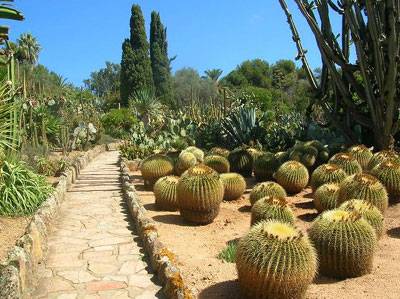

The most cunning and quirky, of course, prepared for the vacation even when they decided to plant cacti in the house. Cacti are desert dwellers, they don't care how long you have been away from home ...
This is what has helped me for several years.
Before leaving, I wear my plants to the shower. I water and bathe. I leave it there for a couple of hours, so that excess water drains and the plants do not experience temperature shock when transferred to the room. Then, I collect all the plants in one room. I don't put one on the windows. There is too much light. The best place for them while I am away is the bright but not sunny middle of the room.
So, we transfer everyone deep into the room, after watering. We cover the windows with tulle. We arrange the plants quite compactly, in the middle - those who are sensitive to the humidity of the air; at the edges - the most hardy and uncaptious. If you have especially delicate specimens (like balsams, cyperus, etc.), think - maybe it makes sense to put them in a pots of water, or even give them to someone for a while.
You can and should place containers with water around the plants. The water will evaporate, making life easier for the flowers. They will be able to absorb the moisture they need with the leaves.
So in the shade and moisture, my plants can wait for me up to three weeks. Checked!
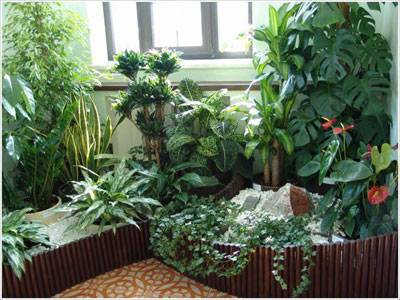

www.u-
Automatic watering systems for indoor plants
The automatic watering system for indoor plants and flowers has a number of outstanding advantages. The automatic watering system allows you to provide indoor plants and flowers with moisture for a very long time.
- Every year automatic watering of plants becomes more and more popular, devices are produced by many well-known companies (Brigadier Werkzeuge (Switzerland), Weninger (Austria), Gardena (Germany), Hozelock (Great Britain), Uniflex (Italy)).
Automatic irrigation systems differ in the type of power supply (solar, electricity, battery), the number of plants watered (from one to several dozen), the method of water intake (water supply, a container with water), the method of water supply (pump or gravity), irrigation settings in the timer ...
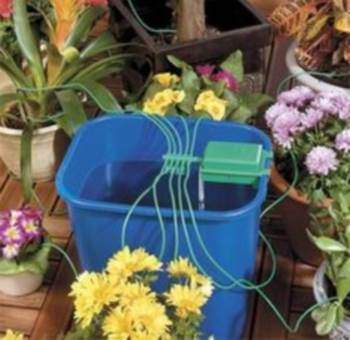

Automatic plant watering system
- The price of an automatic watering system for indoor plants depends on the configuration of the system and the manufacturer.
Do-it-yourself automatic drip irrigation of indoor plants
Automatic watering of indoor plants is quite simple and easy to do on your own using improvised means. Drip irrigation for home flowers is made from a medical drip system that you can buy at a pharmacy.
The system has a built-in regulator that allows you to adjust the frequency of liquid dripping down to a second.
- As with wick irrigation, a container with water (bucket, basin) is placed above the plant, one at the end in the pot, and the other in the container. After installing the automatic irrigation system (dropper), we begin to adjust the dripping frequency.
After a couple of hours and every morning for several days, we check the performance of the drip irrigation system. If everything is in order, then you can safely go on vacation and enjoy all the delights of relaxation!


An example of a homemade drip irrigation system
We hope that now watering indoor plants during the holidays will cease to be a problem as you already know how to water indoor plants in the event of a long absence.
And systems of drip and automatic irrigation of indoor plants will do a good job and preserve the beauty of home flowers.
ADDITIONS TO THE ARTICLE:
1. CORRECT WATERING OF ROOM PLANTS AND FLOWERS - OVERVIEW!
2. WHAT WATER IS NEEDED FOR INDOOR PLANTS? HARDNESS, TEMPERATURE, ETC.
3. HOW TO WATER ROOM PLANTS? ALL WAYS!
We wish you a great holiday and a lot of positive emotions!
With proper care, indoor plants will delight you with beauty for a long time.
Often, along with the beauty and picturesqueness of home flowers, we are faced with problems associated with caring for them. Perhaps the main issue has been and always will be caring for plants during a long absence. I propose to work out together with all possible and easily implemented ways of solving the problem.
Which houseplants are easier to tolerate the absence of owners?
When choosing a remote irrigation system, the individual needs of each flower are taken into account. Some need daily watering, while others can safely live without it for a whole month.
In conditions of moderate temperature and sufficient humidity, indoor plants of different types require the following watering regime:
- daily: azalea, rhododendron, ferns;
- every 2-3 days: dracaena, begonia, cyclamen, dieffenbachia, tolmeya, fittonia;
- 1-2 times a week: orchid, tradescantia, calathea, arrowroot, spathiphyllum, peperomia, columnea;
- Once a week: fuchsia, asparagus, begonia, hibiscus, akalifa, anthurium, cissus, ivy;
- 1 time in 7-10 days: shefflera, philodendron, ficus, lotus, Kalanchoe, yucca;
- 1 time in 10-15 days: cacti, succulents, euphorbia, hoya, aeonium, ceropegia, aloe.
Plants with thick stems and fleshy leaves are more likely to survive in drought conditions. Some plants survive by retaining moisture in special bulbs. Thin-stemmed species and herbaceous plants need frequent watering.
Devices for automatic irrigation and preservation of soil moisture
There are a lot of industrial devices that make life easier for the modern gardener. There are those that will help to water the plants in your absence:
- Capillary mat. A covering made of a special hygroscopic material is placed on any flat surface with polyethylene under it. Pots without pallets are placed on top. The edge of such a "rug" is cut, a narrow strip is lowered into a container of water. The material has a high moisture capacity (up to 3 l / m²), so the technique is effective. Soil moistening is extremely slow, but constantly, eliminating the risk of rot development.In fact, this is an improved version of the "bath" for plants. Some manufacturers even offer an "assembled" design, consisting of two pallets and a capillary mat - water is poured into the outer one, a pot is placed on the inner lined with it.
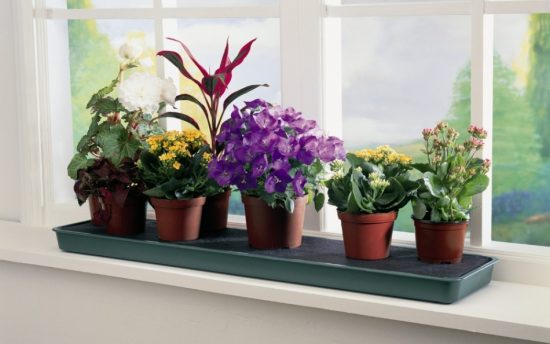

If you are planning a short vacation, you can even do without a container of water, just watering the capillary mat abundantly on the day of departure


Aqua Globes flasks look much more aesthetically pleasing than plastic bottles, but this method of irrigation will not work for large pots and tubs.
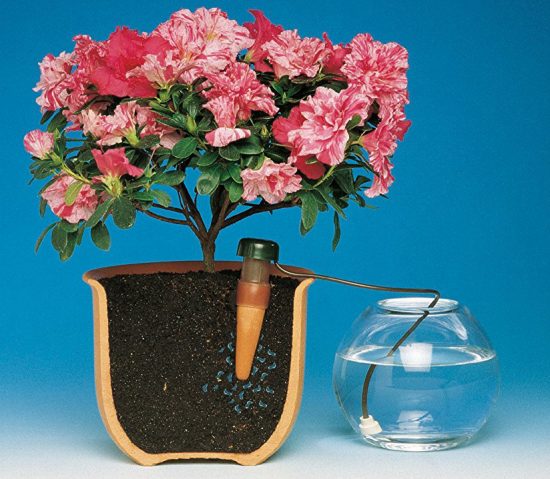

The cones independently analyze the soil moisture level


"Smart" pot allows the owner to be absent for 3–3.5 weeks without worrying about houseplants
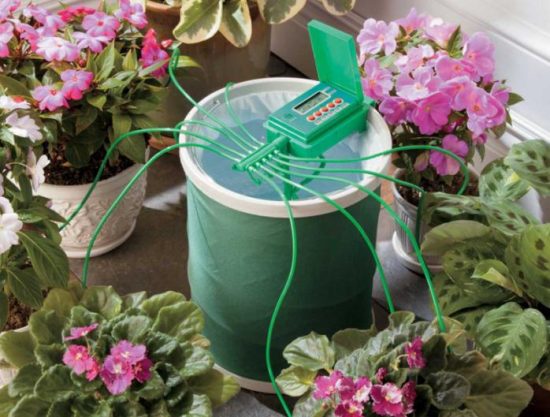

The automatic irrigation system is far from affordable for all amateur flower growers, although many would gladly purchase something similar


Low-quality hydrogel granules, decomposing, release toxic substances into the air - when buying, do not be too lazy to inquire about the presence of a product certificate
Video: automatic watering system for plants
Alternative methods
Of course, do not forget about such options: take the flowers to friends during your absence, or ask someone to come in for watering. Circumstances may arise here when the person whom you entrusted to look after your flora wants to play it safe and floods the plants. Not everyone understands that sometimes excess moisture is worse than lack of moisture. You should explain this in detail to a potential helper, but do not overdo it so as not to frighten the person with responsibility.
Video: watering flowers while on vacation We examined the basic techniques and methods for watering your flower garden while on vacation. If you decide to make the device yourself, let us remind you once again that it is better to test and configure it in advance. If you want to invite a person from the outside for a responsible procedure, you should once again think about the safety of this method.
The plant is placed in a basin on a stand 5-10 cm high, in this case excess water will drain to the bottom of the basin. Use the tape (wick) no more than 3-4 weeks, salinization (contamination) of the pores (fibers) of the tissue occurs.
This is a method for watering large plants. With small plants it is even easier, water is poured into a basin or a large pot (tank)., The container is placed on a raised platform. Plants are placed around and a wick is brought to each.
Read also: Features of planting roses in spring in open ground
I take plastic bottles of different sizes, fill them with water, make a hole in the cork. The bottle is strengthened upside down, that is, with the neck with the cork screwed into the ground. Only the size of the hole needs to be adjusted. I heard that instead of a cork with a hole, someone was plugging the neck of the bottle with a rag.
Enough for 2 weeks for not too picky. Those that require more abundant watering (cyperus, for example) have to be given to someone for a while.
Another hydrogel. We take it dry, soak it, take out the top layer of the earth and mix in the hydrogel there. We cover the surface of the earth with pebbles, expanded clay, sphagnum, etc.
On the automatic watering were: spathiphyllum, arrowroot, calathea, cypress, shefflera, chlorophytum, adiantum, tillandsia, New Guinea balsam, oxalis, 2 syngonium, anthurium, gardenia, stephanotis, ivy, scindaptus, ficus retusa.
Using pallets
On average, this method lasts 10-15 days. A few hours before departure, all indoor plants must be watered abundantly (until the earthy coma is completely moistened), and then the flowerpots with flowers must be placed in wide plastic containers or flower trays. All these additional containers need to be filled with water about 5-7 cm or abundantly moistened river pebbles. The bottom of the flower pots should touch the surface of the water or be in it at a shallow depth. This method of irrigation in the absence of hosts is effective only for plants such as geranium, jerky, palm, chlorophytum, balsam. They are unpretentious and steadfastly survive lack of water, drought and waterlogging.
How to organize automatic watering with your own hands?
Automatic irrigation with the ability to adjust the water supply is done at home on the principle of a drip irrigation system, but with some improvements. Such a system will allow several plants with different fluid requirements to be watered from one reservoir at the same time.
This construction is created like this:
- At the very bottom of the five-liter bottle, you need to make holes with a diameter slightly smaller than the tube of the medical system.
- Hold the ends of the tubes in boiling water so that they become soft.
- Slide them through the holes.
- Treat the joints with silicone or sealant so that there is no leakage.
- Fill the bottle and place it about 1 meter above the pots.
- Place the tubes in flowerpots.
- Adjust the water pressure with the wheel.
Devices for automatic irrigation of flowers from improvised means
Absolutely all modern systems for automatic watering of indoor plants are created in the likeness of long-known home-made structures. Therefore, it is possible to organize watering of flowers during the holidays from available means.
Automatic watering from a dropper.
Watering flowers during your absence or vacation can be handled by a simple medical dropper. To create an automatic sprinkler, you need to attach the dropper tube to the water tank and adjust the flow rate of the drops using the clamp. After that, place the dropper needle on the ground near the roots of the plant, but do not dig it deep into the soil, otherwise it will quickly clog.
Watering flowers while on vacation - dropper
How to water flowers when you leave home
Automatic watering from a plastic bottle.
A regular plastic bottle will also help preserve flowers while on vacation. To make a do-it-yourself drinker for flowers from it, you need to fill the jar with water, put on a thin mesh on the neck, screw the lid and use a needle to punch several small holes in the lid. After that, the drinking jar is turned upside down and deepened into the soil. Water will gradually seep through the holes and the plants will not be left without moisture. But, since the intensity of the bottle watering cannot be adjusted, there is a possibility that the drinker will flood the plant. To avoid this nuisance, use auto watering from a bottle only on large-scale pots and moisture-loving plants.
Automatic irrigation from capillary mats
... Unlike previous methods, autowatering with capillary mats provides the soil with extremely slow but regular moisture. This automatic watering method is very simple: you need to put a wide piece of cloth under the pot and lower its free edge into a container of water. Since the fabric will tolerate moisture well, the soil will be moistened through the drainage holes in the pot.
As a capillary mat, it is best to use a terry towel that gets wet quickly or a ready-made capillary mat.
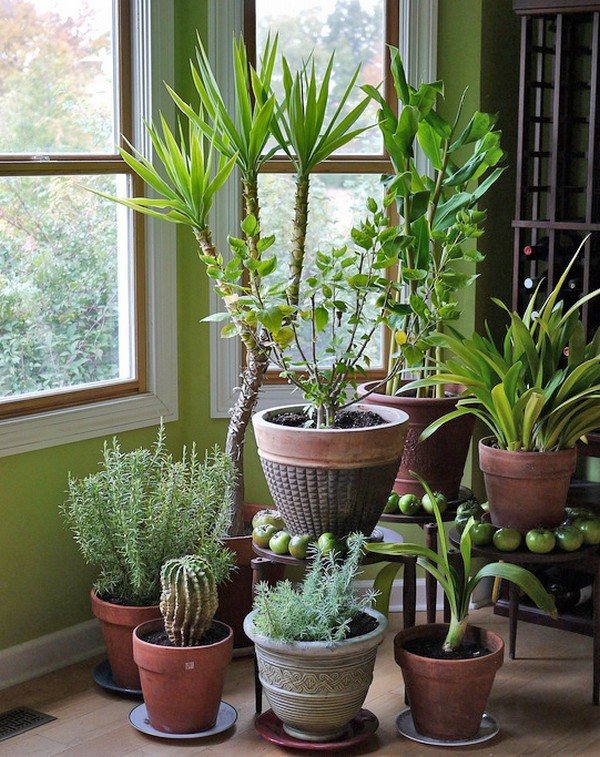

Wick watering.
It implies the transfer of water to plants through a wick - any rope or cord that does not rot from moisture. One end of the wick is placed in a container of water, and the other is deepened into the soil. To ensure faster and better humidification, it is recommended to install the water tank above the level of the pot.
If, shortly before leaving, you decide to transplant flowers, then pull the wick through the drainage hole of the pot and place it on a tray of water. Thus, the root system of the plant will receive moisture without your participation.
We have already figured out a little about how to water flowers when you go on vacation. Now let's look at a few important nuances that will help preserve flowers during your departure:
first, to make the plants dissipate moisture more slowly, move them to a cool and dark place;
secondly, set the pots close to each other so that the most capricious specimens are in the middle;
and, thirdly, whichever system of automatic watering you choose, on the day of departure, water the plants abundantly and spray their leaves.
Also, arrange drainage, moss, or hydrogel around the flowerpots to reduce evaporation. If a plant is very capricious and demanding to care for, cover it with a plastic cap with air holes, thus creating the most favorable microclimate.
A simple way to auto-irrigate flowers while not at home
To make automatic watering of flowers while on vacation truly effective and safe, experiment with it beforehand.Choose the optimal irrigation intensity and the way of automatic water supply, and then your plant pets will reward you with health and beauty.
If you are going on vacation and rejoice in the upcoming pleasant days, then your indoor flowers are unlikely to be as happy as you are, because they will face severe trials and suffering from thirst! Therefore, take care of their well-being in advance.
0:452
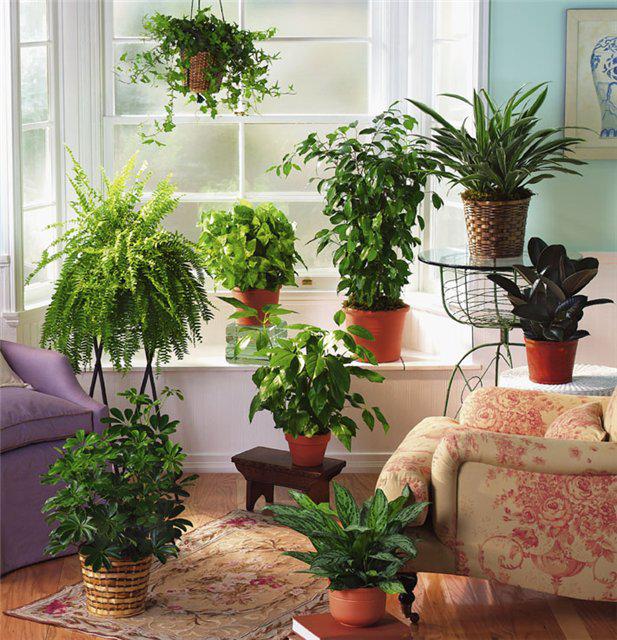

1:958 1:961
Of course, you can ask relatives or neighbors to look after the plants. But what if you don't have any? Then we will resort to the automatic irrigation system! There are many ways to preserve plants.
1:1321
1. Remove the flowers from the windowsill or draw the curtains tighter. The less light, the slower life processes in plants go, which means they need less moisture.
1:1740
2. Water the soil well so that it is saturated with water. The pot can be wrapped with damp newspaper and cellophane on top. This will reduce moisture loss.
1:267
3. Small plants should be covered with plastic or glass caps, bottles, but so that they let air through from below. The evaporated water will condense on the walls and drain back into the ground.
1:649
4. 5-7 days before departure, carefully check if the plants are infested with pests and diseases. Remove all dried and diseased shoots and leaves, as well as large buds and flowers from the plant. Treat diseased plants with appropriate preparations.
1:1135
5. It is better to cut off too large leaves.
1:1211
6. Plants should be placed in a lighted place, but not in the sun.
1:1335
7. Close both doors and windows so that there are no drafts in the room where the plants will remain.
1:1540
8. Stop all types of feeding 2-3 weeks before departure.
1:104
9. If leaving the plants in a pan of water, place the flowerpots on a rock or wooden stand to keep the roots from freezing.
1:393
10. Flowers in ceramic pots tolerate separation better than those that live in plastic containers.
1:595 1:598
If you keep indoor plants in clay pots,
then each pot can be wrapped with moss - both the moss and the plant are abundantly moistened. If there is no moss nearby, place the clay pot in a larger container. Expanded clay should be poured at the bottom, and the gap between the walls of the container should be filled with the same expanded clay. This will maintain a more or less constant soil moisture. The top layer of earth in a pot or container can also be sprinkled with expanded clay, it will interfere with drying.
1:1604
This method is effective if the plants are left for 7-10 days.
1:116 1:119 2:623
A plastic bottle is taken, depending on the volume of the pot, filled with water, a small hole is made in the cork (with a hot gypsy needle), pre-water the flowers and stick the bottles into them with the cork down. As the soil dries, the flower will absorb water from the bottle. It is good to fix it on both sides with chopsticks (for example, from ice cream).
2:1324
Such a dropper lasts 5-7 days. They put several bottles in large flowerpots and the supply will last longer.
2:1518 2:2
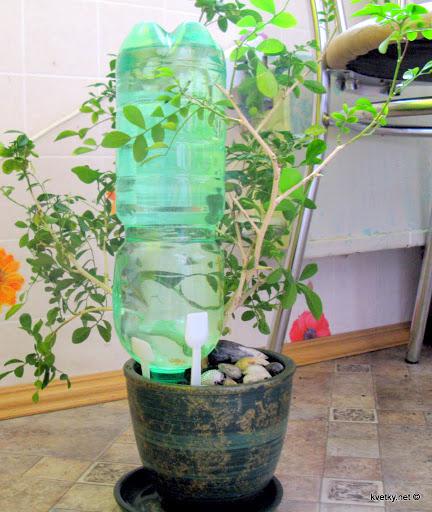

3:506
These can be ropes, laces, woolen threads of different diameters, twisted bandages, and so on.
... One end of the wick must be lowered into a container with water (for example, a basin), and the other must be attached to a pot (for reliability, it will need to be fixed, for example, with a peg). Water will flow to the flowers due to the difference in capillary pressures.
3:1153
One 10 l container is enough for 7 days for 6-7 plants
3:1248 3:1251 4:1755
4:2
Moisture-loving plants can be placed on pallets, deep trays or wide basins of water
so that the bottom of the pot is in the water. The soil from above is covered with moist moss or expanded clay.
4:370 4:373 5:877
Lay oilcloth on the kitchen table
(you can also put the pots in the bathroom, if the plants are not whimsical to light), lay a cloth soaked in water on the oilcloth (cloth, felt, an old baby blanket folded in several layers of batting). Place the pots with already watered plants on the cloth; dip the end of the cloth into a container of water.The pots must have drainage holes; saucers are not needed.
5:1652
This method is suitable for a period of 10-20 days.
5:75 5:78 6:582
You will need your flower pot and another container that you can place under the pot.
Make holes in the pot and thread the string as shown. Place the pot on a vessel with water so that the end of the rope sinks into the water. Water will rise along the rope and moisten the ground.
6:1214
For a pot with a diameter of 10 cm, one wick is enough, and for a pot with a diameter of 25-30 cm, 3-4 wicks are needed for a sufficient supply of water.
6:1479 6:1484 7:1988
7:4
Let's say the Archimedes system,
which consists of a glass bulb - a water tank - and a ceramic cone that is immersed in the ground. Water seeps through the capillary-porous ceramic walls drop by drop and constantly moisturizes the soil. You will have to put several of them in a balcony box or a large pot, of course. Looks, by the way, very cute! From an aesthetic point of view, this is perhaps the most glorious option. Cost - about 180 rubles per piece. A cone in a flower pot lasts 5-7 days
7:970 7:973 8:1477 8:1480 9:1984 9:2
Or here - Blumat cones,
only besides the cone, some kind of remote container with water is required.
9:171
The cone itself is placed in a pot, and the tip of the hose with the weighting agent is lowered into a container of water. These devices draw water "on demand" - when the soil in the pot dries up, the cone gradually releases water to the surrounding land.
9:574 9:577
Inconvenience
the fact that the container with water should be higher or at least at the same level with the pots. You don't always fit in, to be honest. Well, the price is not very happy - about 4 thousand for 25 cones.
9:934 9:937 10:1441
Remember that all of the above methods are designed for a maximum of three to four weeks of your absence.
... If you have to leave for a longer period, then you cannot do without complex store-based automatic irrigation systems.
10:1883
10:2
The most popular thing is Gardena,
which is capable of watering, according to the manufacturer, up to 36 plants at the same time. Sold in OBI and other large shopping centers. The kit includes a pump with a filter, a transformer with a timer for powering the pump, a supply hose, three distributors (each with 12 outlets), a capillary hose, pegs, end caps and a plastic water container, 9 liters.
10:743 10:746
One or several branches can be connected to each plant - you will have to find out the right amount empirically. If, for example, 60 ml of water per day is not enough for plants in a large container (namely, that much has time to flow out per minute), the amount of moisture supplied will have to be increased by installing additional capillary tubes. The hose is attached to the pump, the pump is immersed in the above tank, the system starts to work. If the water in the tank suddenly runs out, the pump will turn off automatically, and when water is added, it will continue to function.
10:1750
Inconvenience
- an outlet is required to which the system will be connected. Costs from 3 thousand rubles per set
10:218 10:221 11:725 11:728 12:1232
Do you know?
12:1263
... that Tradescantia, begonia, dracaena easily tolerate a temporary lack of moisture (up to 7 days)
12:1427
... that aloe, agave, euphorbia tolerate temporary "droughts" and love sunlight, so it is better to leave them in the room on the windowsill, after well watering them.
12:1759
... that the palms and ficuses that live on the balcony should be brought into the room during the holidays. They are also unpretentious to moisture, but in three weeks of your absence they can get sick.
12:314 12:317
Before you leave home for a long time and provide the flowers with regular watering with the help of special devices, the plants must be prepared in advance. To do this, it is recommended to carry out the following procedures:
- Stop feeding 14 days before vacation. After fertilization, the plants need water to better absorb the minerals.
- Carry out partial pruning of leaves, buds, without damaging the flowers. So the evaporation of moisture will be slower.
- Carry out pest control, treat the flower if necessary.
- Place the pots in a darkened part of the room, farther from windows, or draw curtains. Reducing illumination, lowering the temperature will reduce evaporation.
- Move the pots closer to each other, collecting them in a compact group. This will create a humid microclimate.
- Flowers that like high humidity can be covered with polyethylene, securing it around the container with an elastic band. Glass containers are suitable for small seedlings.
- Eliminate drafts by closing all doors and windows.
- Water the plants before going on vacation, using more water than usual. It is important not to overflow the flowers! For some indoor flowers, use the immersion method.
- Clay pots can be overlaid with damp moss or wrapped in a damp cloth, and on top with polyethylene, after moistening the soil.
- Create high humidity by laying a layer of gravel, expanded clay on the bottom of a large pot. Put a flowerpot with a plant on top and pour water so that it does not touch the bottom of the container with a flower.
Professional holiday flower care products
| Name | Characteristics, principle of operation | How long will it last | Price in rubles |
| Aqua Globes system | Round glass flask with a long, narrow spout. Liquid is poured into the structure, and the tip is lowered into the soil. When the soil dries up, the process of gas formation begins: air bubbles fall inside the flask, and water drops flow out, soaking the soil. Manufacturer Masterprof. | 383 per pack of 2 | |
| Ceramic cone Blumat | The device for watering flowers while on holiday consists of a cone-shaped ceramic funnel placed in the soil, a tube that is lowered into a vessel with liquid, and a sensor. When the ground is dry, the sensor is triggered and starts the process of supplying water. | Works until the water tank is empty | |
| Capillary mat | Made from synthetic fibers, sewn through polyethylene. The mat absorbs moisture, distributes it evenly over the entire surface, and, if necessary, gives it to the plants that stand on it | Depends on the number of pots that are located on its surface | |
| Tray with capillary carpet | It consists of an external tray, where the liquid is poured, an internal tray, which is inserted into the external one, and a capillary mat, on which flower pots are placed. The carpet absorbs moisture and releases it to the plants. | Up to 2 weeks | |
| Smart flower pot | At the bottom of the pot there is a liquid storage and supply system. Part of the moisture after watering remains inside, and then, during the drying out of the soil, it is evenly distributed over it. Some models have a built-in indicator that regulates the flow of liquid and its speed | Up to 12 weeks |
Watering with plastic bottles
First, a bottle of one and a half or two liters must be prepared. To do this, you need a long nail or awl heated on fire, with the help of which you need to make two holes: one on the bottom of the bottle, and the other on the lid. The bottle is filled with water, the cap is screwed on and the neck is turned upside down. In this position, drip irrigation will be carried out, which is well suited for large indoor plants. It is advisable to use it before the trip and observe how much water comes out of plastic containers of different volumes and for how many days it lasts. It is important to note how much water the plant receives per day. This will help you to choose an irrigation vessel individually for each flower, in which there is enough water for all vacation days. This method can solve the problem of watering for 15-20 days.
Wick irrigation


This method of watering is widespread, but it is most suitable for different types and varieties of violets. True, to implement it, you will first have to transplant the plants into a flower pot with a wick at the bottom.A wick or an ordinary cord, which absorbs and retains moisture well in a short time, is placed in the form of a small ring at the bottom of the pot under the soil substrate (one end of it). The other end of the cord is passed through a hole in the bottom of the flower container and dipped into a vessel with water, which is located under it. The entire wick gets wet and seems to draw water from the lower vessel into the soil with the plant. This method is only suitable for small plants.
Temporary wick watering is possible with a slight change in this method. As a wick, you can use a cloth rope or a cord made of synthetic materials. The main thing is that it can absorb moisture well. On one side, it must be lowered into a container with water (for example, in a bucket or jar) located on a table or pedestal, and the other must be placed on the surface of the soil in a pot with a plant. A mandatory point in this method is the location of the container with water at a higher level than the flower pot is. All plants can be placed directly on the floor, and the sources of moisture can be placed on a nearby stool.
It is recommended to try this irrigation method in advance and decide on the number of wicks. For a small flower, one wick will most likely be sufficient, and for a large indoor culture, several copies may be required. Such watering is enough for an average of 7-10 days, if the wick does not dry out from too high summer air temperature.
Nowadays, you can buy ready-made modern irrigation systems with a wick.

